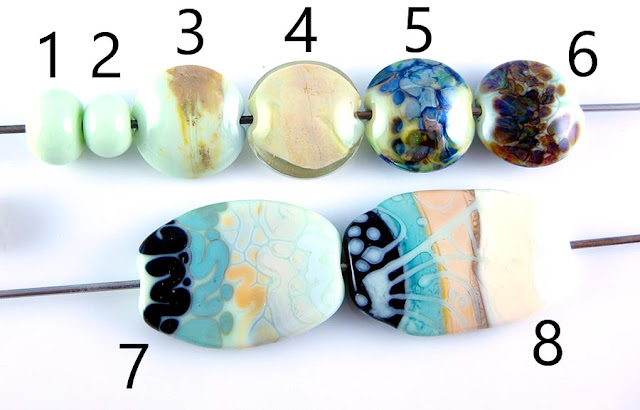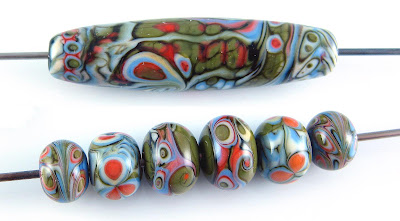1 - Plain, 2 - Plain (reduced), 3 - w/ Silver Leaf, 4 - w/ Silver Leaf (reduced & encased), 5 - w/ Silver Glass Frit (reduced), 6 - w/ TerraNova2 Frit, 7 & 8 - w/ Tuxedo, Copper Green, Opal Yellow, Ivory and Peace
Both CiM Sprout and CiM Cardamom are light green opaque colours, however what I'm seeing is that Sprout is a bit lighter, and much less yellow. It's a brighter, more cheerful colour than CiM's other production pale green, Dirty Martini (which I have yet to test.... hopefully soon!), which I love very much. All of these colours are wonderful, but I think Sprout might just be my favourite of the three.
Sprout's reaction profile is much different than Cardamom's, and I won't be able to compare it to how Dirty Martini behaves until I've tested that colour. However at first blush I think I'll guess that these reactions and the reactions Dirty Martini shows us will have more in common than the reactions I got with Cardamom.
Sprout doesn't seem to change colour or have any other odd surface reaction when it is reduced.
On top of Sprout, silver turns a pinkish orange colour when it is simply burnished on and then melted into the surface of the glass. When the silver is reduced and encased, it forms a pinkish peach 'blanket' under the clear.
The other thing that's very interesting about the bead I reduced and encased is that the colour of the Sprout has turned very yellow, looking much more like CiM Cardamom. What I don't know (because I didn't test it *sigh*) is whether the silver is necessary for this discolouration or if Sprout will always look yellower under encasement. It's hard to think of everything... especially since everything just looks orange when it's hot.
Another plus: Sprout didn't crack when I encased it.
Now, I'm not thrilled with the colours that Sprout pulled out of my silver glass, but I think there's some interesting potential here. In the bead on the left, with my reducing silver glass frit, you can see some brownish/yellowish fuming around some of the fritty bits. I got nice blues and nice shine out of my frit blend on that bead.
Regarding the bead on the right, I got a few good colour spots from my TerraNova2 frit which seem to indicate that the striking might just be slower on top of this colour. The most exciting thing about this bead is the weird haloed veining that occurred in the Sprout underneath the TerraNova2. You can see the light green that has risen up around the frit, and then the much darker green, grouty 'veins' between them. Neat.
When Tuxedo is used on top of Sprout, some subtle bleeding occurs. You can see that the Sprout, around the Tuxedo, has turned darker and sort of blueish. When Sprout is used on top of Tuxedo, the Sprout separates. And it separates in the exact opposite way from how colours usually separate, with the thinned out, translucent side of the separation on the outside of the dots and stringer lines and the more opaque centre of the separation being on the inside of the dots and stringer lines. Weird.
Sprout seems to be another one of those colours that helps Copper Green not to go all grey when they are used together. On top of Sprout, Copper Green seems to develop a faint dark line reaction. When Sprout is used on top of Copper Green, the line is turquoise.
Opal Yellow on top of Sprout is pure weirdness. The Opal Yellow has spread, and my dots and lines seem almost to form a mosaic, with darker veins like grout between them. The effect is especially cool because there is also a pale green halo around the Opal Yellow, resulting in two distinct reaction lines instead of the usual one. Opal Yellow seems to want to strike very butter-yellow both on top of and underneath this colour, although in a sort of patchy way.
Ivory on top of Sprout has to be the coolest thing in these tests. Like Opal Yellow, Ivory spreads out on top of Sprout and develops faint green halos around it and that interesting green grout reaction. Ivory has the additional feature of having separated in a wierd, shaded way. It almost looks like someone drew the Ivory lines on with oil pastels and did some blending, because the effect is very stylized. When Sprout is used on top of Ivory, it sort of gets swallowed.
Nothing very interesting happens between Sprout and Peace, but it's hard to feel sad about that when there's so much else going on. If anything, Peace seems to steal colour from the Sprout because my white lines and dots don't look all that white on top of Sprout.
So, now I need to tell you that there isn't much of this available. Frantz Art Glass has it in their funhouse currently, and you can buy 1/4# at a time. If you really have a burning need for this colour, the best place I've found to purchase it is at Artistry in Glass in Ontario, because they haven't imposed a quantity limit.

































